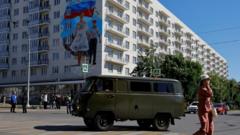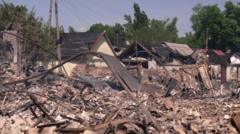As the conflict between India and Pakistan intensifies, echoes from the past reveal stark contrasts and alarming similarities.
Escalating India-Pakistan Tensions: A Historical Perspective

Escalating India-Pakistan Tensions: A Historical Perspective
A journalist recalls the rapid escalation of conflict in Kashmir and its implications in a modern context
In a significant escalation of the long-standing tensions between India and Pakistan, the situation has now reached levels reminiscent of the 1971 war. According to journalist Hari Kumar, who reflected on this tumultuous history, the current circumstances are unprecedented in terms of the technological advancements and the rampant spread of disinformation within the media landscape.
Kumar recalls his childhood in 1971, a time when the sound of air raid sirens and military drills created a palpable sense of fear among civilians, which many are now experiencing again in the light of the latest offensive actions. Unlike the previous conflict, where information was disseminated through a handful of radio stations, contemporary warfare is heavily affected by the toxic influence of social media, complicating factual reporting and misleading the public.
The recent hostilities, particularly focused in the northern border regions of Kashmir, have seen both nations utilising drones and missile technology to conduct strikes on populated areas, marking a significant shift in military tactics. Kumar emphasizes that despite the modernization that has positioned India as a burgeoning technological powerhouse and one of the largest global economies, this has paradoxically increased the risks of a broader confrontation.
Moreover, the fierce nationalist sentiment among the populace persists, yet its manifestations in today's world differ notably from those of the past. Community support for the military, as witnessed in traditional fundraisers during the 1971 conflict, has given way to digital expressions of patriotism, indicating the evolution of warfare and public sentiment in the context of modern communication.
As tensions continue to rise, it remains to be seen how these dynamics will evolve, and whether the lessons from India and Pakistan's shared history will influence the path forward in this ongoing conflict.
Kumar recalls his childhood in 1971, a time when the sound of air raid sirens and military drills created a palpable sense of fear among civilians, which many are now experiencing again in the light of the latest offensive actions. Unlike the previous conflict, where information was disseminated through a handful of radio stations, contemporary warfare is heavily affected by the toxic influence of social media, complicating factual reporting and misleading the public.
The recent hostilities, particularly focused in the northern border regions of Kashmir, have seen both nations utilising drones and missile technology to conduct strikes on populated areas, marking a significant shift in military tactics. Kumar emphasizes that despite the modernization that has positioned India as a burgeoning technological powerhouse and one of the largest global economies, this has paradoxically increased the risks of a broader confrontation.
Moreover, the fierce nationalist sentiment among the populace persists, yet its manifestations in today's world differ notably from those of the past. Community support for the military, as witnessed in traditional fundraisers during the 1971 conflict, has given way to digital expressions of patriotism, indicating the evolution of warfare and public sentiment in the context of modern communication.
As tensions continue to rise, it remains to be seen how these dynamics will evolve, and whether the lessons from India and Pakistan's shared history will influence the path forward in this ongoing conflict.





















